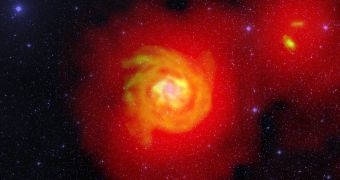A group of investigators led by West Virginia University astronomer D. J. Pisano recently announced the discovery of a massive river of hydrogen flowing through space, the first finding of this type ever reported. The study may contribute significantly to our understanding of how spiral galaxies continue to form new stars even when they are very old.
Pisano and his team conducted their research using the US National Science Foundation’s (NSF) Robert C. Byrd Green Bank Telescope (GBT), which is a part of the National Radio Astronomy Observatory's (NRAO) site at Green Bank, West Virginia.
GBT provides unique capabilities for conducting observations at meter and millimeter wavelengths, particularly through its 100-meter (328-foot) primary antenna. The massive collecting area is entirely steerable, meaning that as much as 85 percent of the night sky at the site can be covered.
In the new study, the telescope was able to discover a very faint, very tenuous filament of gas streaming into NGC 6946, a galaxy located relatively close to the Milky Way. Pisano says that this discovery may help explain how large and old spiral galaxies are still able to support stellar formation.
When galaxies are very young, they produce dozens or even hundreds of new, blue stars per years, mostly due to the fact that they have massive molecular hydrogen reserves available. As they age, the amount of gas available drops, and so does the rate at which stars form.
Still, previous astronomical investigations have revealed that many spiral galaxies continue to produce new celestial fireballs even beyond the point when all of their gas reserves should have been exhausted.
“We knew that the fuel for star formation had to come from somewhere. So far, however, we’ve detected only about 10 percent of what would be necessary to explain what we observe in many galaxies,” Pisano explains. He is the author of a new paper detailing the findings, published in a recent issue of the esteemed Astronomical Journal.
“A leading theory is that rivers of hydrogen – known as cold flows – may be ferrying hydrogen through intergalactic space, clandestinely fueling star formation. But this tenuous hydrogen has been simply too diffuse to detect, until now,” he goes on to say.
Using the power of the GBT on the nearby NGC 6946, located just 22 million light-years away between the constellations of Cygnus and Cepheus, revealed the first signs of such a cold flow. Other radio telescopes, Pisano says, are simply not sensitive enough to detect this gas.
The team now plans to conduct a series of confirmation studies. According to theory, a small population of new stars should exist inside these filaments. If experts are able to identify these stellar objects, then this would represent concrete proof that cold flows have finally been detected.

 14 DAY TRIAL //
14 DAY TRIAL //